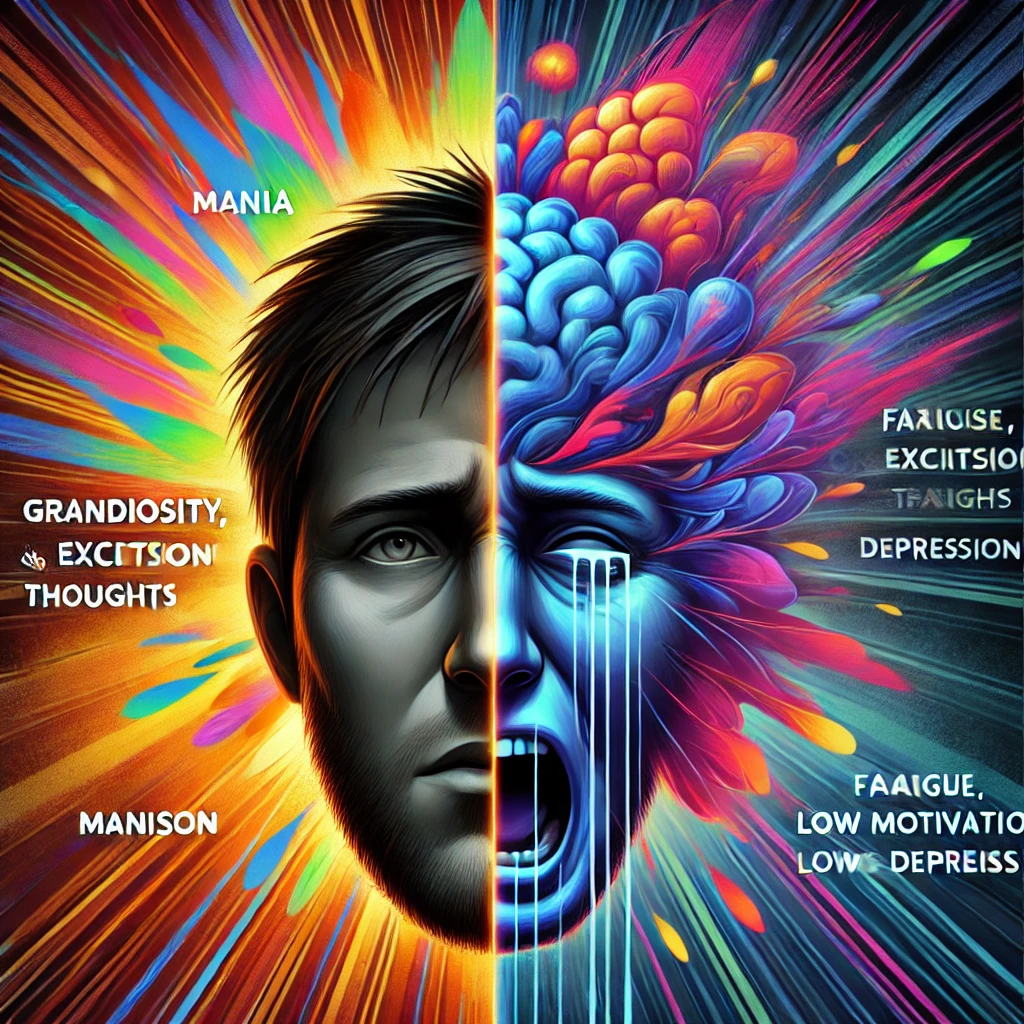
Bipolar Affective Disorder (BPAD)
Definition
- Bipolar Affective Disorder (BPAD) is a chronic mood disorder characterised by episodes of mania/hypomania and depression, with periods of normal mood (euthymia) in between.
- Subtypes:
- Bipolar I Disorder: At least one manic episode (with or without depressive episodes).
- Bipolar II Disorder: At least one hypomanic episode and one major depressive episode (no full mania).
Cyclothymia: Chronic mood instability with mild depressive and hypomanic symptoms (not meeting full criteria for BPAD).
Causes & Risk Factors
- Dysregulated Monoamine Neurotransmitters → ↑ Dopamine & Noradrenaline (Mania), ↓ Serotonin (Depression).
- Structural & Functional Brain Changes → Hyperactivity in Limbic System, Reduced Prefrontal Cortex Control.
Genetic & Environmental Triggers → Stress, Trauma, and Sleep Disruption Can Precipitate Episodes.
Risk Factors for BPAD
|
Risk Factor |
Description |
|
Genetic Predisposition |
Strong Family History (~80% Heritability). |
|
Early Life Stress & Trauma |
Childhood Abuse, Neglect, Loss of Parent. |
|
Substance Misuse |
Alcohol, Cannabis, Cocaine Can Trigger Episodes. |
|
Sleep Disruption |
Shift Work, Jet Lag, Insomnia Can Precipitate Mania. |
|
High-Stress Lifestyle |
Work Pressure, Major Life Events. |
|
Comorbid Psychiatric Disorders |
Anxiety, ADHD, Personality Disorders. |
🔹 BPAD has a strong genetic component, but environmental factors influence episode triggers.
Clinical Features
Symptoms of BPAD
“E-H-D-M” → Energetic Hikes Don’t Match
- E → Elevated mood (Manic Episode) → Grandiosity, Decreased Sleep, Racing Thoughts, Pressured Speech, Risk-Taking
- H → Hypomanic (Milder Mania) → Similar to Mania, but no Psychosis or Hospitalisation
- D → Depressive Episode → Low Mood, Anhedonia, Fatigue, Sleep Changes, Suicidal Thoughts
M → Mixed Episode → Mood Shifts, High Energy with Suicidal Ideation
Signs on Examination
|
Feature |
Mania |
Depression |
|
Speech |
Pressured, Rapid, Loud. |
Slow, Monotonous, Reduced. |
|
Mood & Affect |
Euphoric, Irritable, Labile. |
Low, Flat, Tearful. |
|
Thought Form |
Flight of Ideas, Tangential. |
Slow, Pessimistic. |
|
Energy Levels |
Hyperactive, Insomnia. |
Fatigue, Hypersomnia. |
|
Psychotic Features |
Grandiose Delusions, Hallucinations. |
Mood-Congruent Delusions, Nihilism. |
🔹 Mania is more severe than hypomania and often requires hospitalisation.
Referral Criteria (NICE Guidelines)
Urgent Referral (If Severe Symptoms or Risk to Self/Others)
- Acute Mania With Severe Functional Impairment or Psychotic Symptoms.
- Severe Depression With Suicidal Ideation or Psychotic Features.
- Rapid-Cycling Bipolar Disorder (>4 Mood Episodes in 12 Months).
- High-Risk Behaviours (Reckless Spending, Hypersexuality, Self-Neglect).
Routine Referral (If Symptoms Persist or Affect Functioning)
- Recurrent Mood Episodes Affecting Work & Relationships.
- Failure of First-Line Medication.
- Suspected BPAD in Adolescents or Young Adults.
🔹 Manic episodes usually require urgent psychiatric referral.
Diagnosis
Clinical Diagnosis (DSM-5/ICD-10 Criteria)
Mnemonic: “D-ME-PF” → Duration, Mood, Energy, Psychotic Features, Functional Impairment
(Think: “Does My Energy Peak Fast?” to recall the key features quickly.)
Breakdown:
| Criterion | Mania → “7-EVIL“ | Hypomania → “4-EASY“ | Depression → “2-DOWN“ |
|---|---|---|---|
| D – Duration | ≥7 Days (SEVERE) | ≥4 Days (MILD) | ≥2 Weeks (PERSISTENT) |
| M – Mood | Elevated, Expansive, Irritable | Elevated, Less Severe | Depressed, Anhedonia |
| E – Energy | Very High, Insomnia | Moderate Increase | Fatigue, Low Motivation |
| P – Psychotic Features | Present (Delusions, Hallucinations) | Absent | Possible in Severe Cases |
| F – Functional Impairment | Severe, Often Needs Hospitalisation | Mild-Moderate | Significant Impairment |
Quick Way to Remember Each Episode Type:
- Mania → “7-EVIL” (Severe, high energy, psychotic, needs hospitalization)
- Hypomania → “4-EASY” (Mild, functional, no psychosis)
- Depression → “2-DOWN” (Persistent sadness, fatigue, possible psychosis)
Differential Diagnosis
|
Condition |
Key Differences |
|
Schizoaffective Disorder |
Psychotic Features Persist Outside Mood Episodes. |
|
Borderline Personality Disorder (BPD) |
Mood Swings Are More Reactive & Short-Lived. |
|
ADHD |
Inattention & Impulsivity Without Mood Cycling. |
|
Substance-Induced Mood Disorder |
Symptoms Resolve After Substance Withdrawal. |
🔹 Diagnosis is clinical, supported by mood diaries and psychiatric assessment tools.
Management (NICE Guidelines)
Acute Episode Management
|
Episode |
First-Line Treatment |
|
Acute Mania |
Atypical Antipsychotic (Olanzapine, Risperidone, Quetiapine) ± Mood Stabiliser. |
|
Acute Depression |
Quetiapine, Lamotrigine, or Fluoxetine + Olanzapine. |
|
Mixed Episode |
Valproate ± Antipsychotic. |
Maintenance Therapy (To Prevent Relapse)
|
First-Line Maintenance |
Drug Options |
|
Mood Stabiliser |
Lithium (Gold Standard). |
|
Alternative Mood Stabiliser |
Valproate, Lamotrigine. |
|
Atypical Antipsychotic |
Quetiapine, Olanzapine, Aripiprazole. |
🔹 Lithium is the most effective long-term treatment for BPAD.
Lifestyle & Psychological Interventions
- Psychoeducation & Mood Monitoring.
- Cognitive Behavioural Therapy (CBT) for Depression.
- Interpersonal & Social Rhythm Therapy (IPSRT) to Stabilise Daily Routines.
- Avoiding Triggers: Stress, Sleep Deprivation, Substance Use.
🔹 Medication is first-line, but therapy helps prevent relapse.
Prognosis & Complications
Prognosis
|
Condition |
Outcome |
|
Well-Controlled BPAD (With Treatment) |
Stable Mood, Functional Life. |
|
Recurrent Relapses (Without Treatment) |
Severe Impairment, Suicide Risk. |
Complications of BPAD
|
Complication |
Features |
|
Suicide Risk |
High During Depressive & Mixed Episodes. |
|
Substance Misuse |
Self-Medication With Alcohol, Drugs. |
|
Financial & Legal Issues |
Impulsive Spending, Risky Behaviours. |
|
Relationship Breakdown |
Strained Family & Social Ties. |
🔹 BPAD has a high suicide risk, especially during depressive episodes.
UKMLA Key Points
- Best first-line treatment for acute mania: Atypical Antipsychotic (Olanzapine, Risperidone).
- Best first-line treatment for bipolar depression: Quetiapine or Lamotrigine.
- Best long-term maintenance treatment: Lithium.
- When to refer urgently: Severe mania, psychosis, suicidality.
- Avoid antidepressants in BPAD without a mood stabiliser (risk of triggering mania)